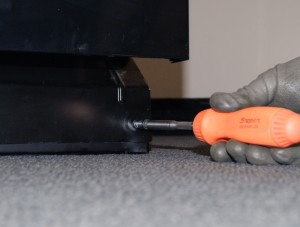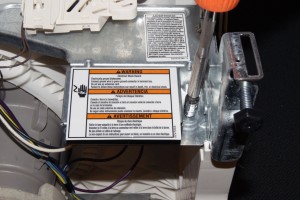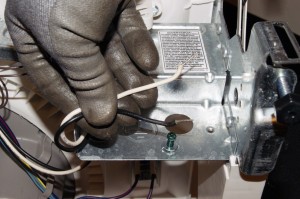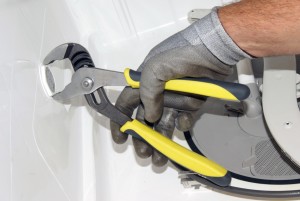How to replace a dishwasher drain hose

This dishwasher repair guide shows how to replace the drain hose that connects the drain pump to the drain line that carries water to the sink drain. If the drain hose leaks, remove it and replace it with a manufacturer-approved replacement part.
This procedure is for Kenmore, Whirlpool, KitchenAid, Maytag, JennAir and Amana dishwashers. You also can use the same basic steps to replace the drain hose in some GE, Frigidaire, Electrolux and Samsung dishwashers.
Instructions
- 01.
Shut off electrical power and water supply to the dishwasher
Flip the house circuit breaker switch to the Off position to completely disconnect electrical power to the dishwasher (some older homes instead have a fuse that you remove from the fuse box). To verify that power is disconnected, make sure the display on the control panel can't be activated.
Find the water supply valve for the dishwasher under the sink (or in the basement). Close the valve to shut off the water supply going to the dishwasher.
- 02.
Remove the bottom front access panel and toe panel
Using a 1/4-inch nut driver, remove the screws that hold the front access panel in place. Pull the access panel and the toe panel forward, remove them and set them aside.
Tip: Refer to your installation manual for more details on removing the bottom front access panel and the toe panel, if necessary.
PHOTO: Remove the bottom front access panel screws.
- 03.
Pull out the dishwasher
The junction box is at the front of the dishwasher just behind the bottom front access panel. Remove the cover on the junction box and disconnect the wires.
Remove the 2 mounting screws from the brackets that secure the dishwasher in the cabinet opening.
Pull the dishwasher out from under the counter. You should have enough slack in the water supply line and the drain hose to pull the dishwasher in front of the counter opening for the dishwasher.
Tip: You might have enough slack in the electrical supply wiring so that you can pull out the dishwasher without disconnecting the wires.
PHOTO: Remove the junction box cover.

PHOTO: Disconnect the wires.
- 04.
Disconnect the drain hose from the drain pump
Reach under the dishwasher and squeeze the wire hose clamp that holds the drain hose to the drain pump—use pliers if necessary. Pull the end of the drain hose off of the drain pump.
Tip: Place a towel under the drain pump to absorb water from the drain hose.
PHOTO: Release the drain hose spring clamp.

PHOTO: Disconnect the hose from the drain pump.
- 05.
Remove the drain hose from the water inlet assembly
From the inside of the dishwasher tub, use a pair of channel lock pliers to remove the plastic nut that secures the water inlet assembly.
The water inlet assembly secures the drain hose to the outside left panel of the dishwasher tub. Pull out the water inlet assembly to release the drain hose from the bracket.

PHOTO: Loosen the plastic water inlet nut.

PHOTO: Remove the plastic water inlet nut.

PHOTO: Release the drain hose from the water inlet.
- 06.
Disconnect the drain hose from the drain line to the sink
Separate the drain hose that goes to the kitchen sink drain from the dishwasher drain hose that extends to the drain pump.
Pull the drain hose from under the dishwasher and discard it.
Tip: If needed, use pliers to squeeze the wire clamp to remove the drain hose.
PHOTO: Disconnect the drain hose.

PHOTO: Pull out the dishwasher drain hose.
- 07.
Connect the new drain hose
Attach the new dishwasher drain hose to the drain pump, carefully working the hose onto the drain pump outlet and onto the connection so it seats properly and does not leak. Secure it with the wire hose clamp.
Route the new drain hose through the water inlet bracket the same way the original drain hose was routed.
Reconnect the portion of the drain hose that goes to the kitchen sink drain to your newly installed drain hose. Make sure that the connection is secure.
Tip: The new drain hose fits tightly on the drain pump. It usually requires significant force to work the drain hose onto the drain pump outlet.
PHOTO: Connect the hose to the pump.

PHOTO: Route the drain hose through the water inlet.
- 08.
Reinstall the water inlet bracket
Position the water inlet bracket on the side of the tub so you can screw the plastic nut onto the bracket from the inside of the tub.
Carefully screw the plastic nut onto the water inlet from the inside of the tub. Hand tighten the nut and then carefully tighten it another 1/4 turn to seal the inlet.
Tip: Don't overtighten the nut, because you could crack the plastic nut or the tub.
PHOTO: Tighten the plastic nut.
- 09.
Reinstall the dishwasher
Carefully push the dishwasher back under the counter. Reconnect the wires in the junction box and reinstall the junction box cover. Replace the bottom front access panel and toe panel.
Insert the screws into the mounting brackets that secure the dishwasher in the counter and tighten the screws.
Position the toe panel on the dishwasher and then position the access panel in front of the toe panel. Insert the mounting screws and tighten the screws firmly.
Tip: Refer to the dishwasher's installation guide for additional guidance. - 10.
Restore the water supply and electrical power
Open the water supply valve to restore the water supply to the dishwasher. Reset the house circuit breaker to restore electrical power.
Most common symptoms to help you fix your dishwashers
Choose a symptom to see related dishwasher repairs.
Main causes: broken door spring, damaged or broken door hinge…
Main causes: damaged or stuck spray arm, leaking door seal, damaged door hinge, leaky heating element water seal, cracke…
Main causes: broken door latch, tripped circuit breaker, broken heating element, faulty vent fan, sensor failure, contro…
Main causes: improper loading, low water temperature, improper detergent dosage, detergent dispenser failure, spray arm …
Main causes: clogged kitchen sink drain, clogged drain hose, drain check valve damaged, drain pump failure, control syst…
Main cause: damaged rack height adjuster…
Main causes: glass or popcorn kernel stuck in the chopper blade, drain line vibrating against the cabinet, debris in was…
Main causes: not using rinse aid, rinse aid dispenser failure, broken heating element, malfunctioning vent, drying fan f…
Main causes: light switch beside the sink turned off, lack of power, bad dishwasher door switch, control system failure,…
Most common repair guides to help fix your dishwashers
These step-by-step repair guides will help you safely fix what’s broken on your dishwasher.

How to replace a dishwasher door latch assembly
If the dishwasher door doesn't click shut, a broken door latch is a likely cause. Follow these instructions to replace i…

How to replace a dishwasher user interface control
The user interface control houses the selection buttons and display. If it fails, you can't select the cycle and setting…

How to replace a dishwasher thermal fuse
A completely dead control panel often indicates that the thermal fuse on the electronic control board is blown; follow t…
Effective articles & videos to help repair your dishwashers
Use the advice and tips in these articles and videos to get the most out of your dishwasher.

Get tips on completing essential holiday cleaning tasks to brighten your home.…

Learn about all the convenient features on our Sears PartsDirect website that make your parts purchases easier.…

Get answers to frequently asked questions about Sears and Sears PartsDirect.…
